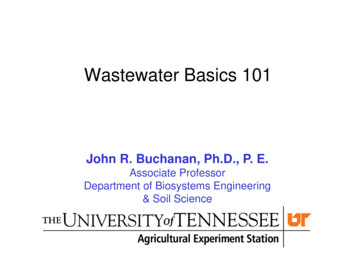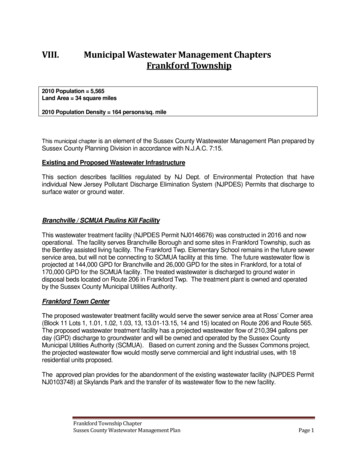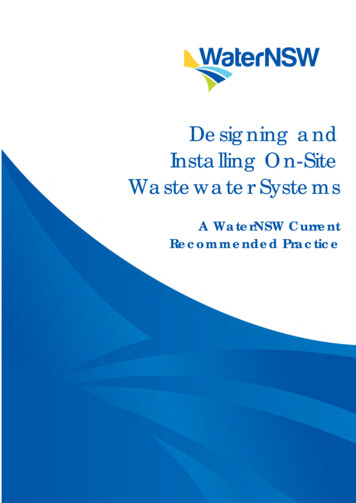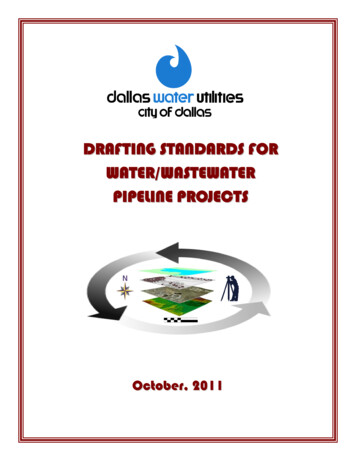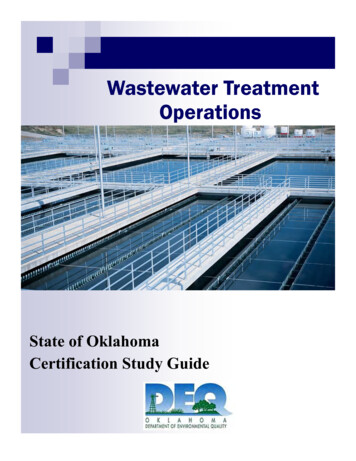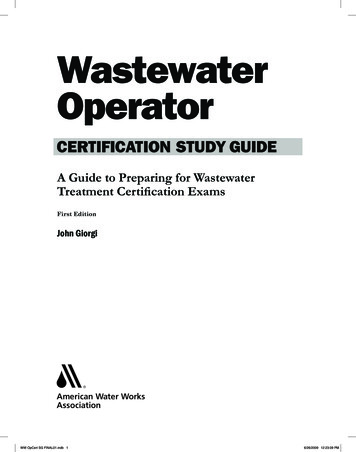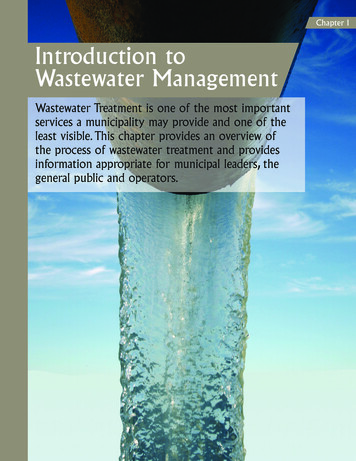
Transcription
Chapter 1Introduction toWastewater ManagementWastewater Treatment is one of the most importantservices a municipality may provide and one of theleast visible. This chapter provides an overview ofthe process of wastewater treatment and providesinformation appropriate for municipal leaders, thegeneral public and operators.
Handbook on Wastewater ManagementChapter 1: Introduction to Wastewater ManagementChapter 2: Asset Management and SustainabilityChapter 3: Financial Management & Rate StructuresChapter 4: Regulatory Overview and Legal ResponsibilitiesChapter 5: Educating and Engaging the Public on Wastewater TreatmentChapter 6: Stormwater Management and MS4sChapter 7: Collection SystemsChapter 8: Staff Training Demands, Succession Planning and CertificationChapter 9: NYWARN – Water/Wastewater Agency Response NetworkAppendix 1: Glossary of TermsAppendix 2: Financial Glossary1-2
Introduction to Wastewater ManagementChapter 1:Introduction to Wastewater ManagementWastewater 101How do we collect the wastewater?The sewer or collection system is designed soOverviewthat it flows to a centralized treatment location. Thehe section provides an overview of wastewatercollection system is comprised of smaller sewers withtreatment and is intended to provide a briefa diameter of about four inches. As more homes anddescription of what processes may be at yourcompanies are connected along the system, the pipeswastewater plant. Although each plant is designed become larger in diameter. Where gravity systems arefor particular conditions, there are many similaritiesnot practical, pumping stations are often included to liftin how different processes operate. There may bethe wastewater.differences between your plant and a neighboring plantIn New York State and in many other states, there arein terms of size, ground area, shape of tanks (circular or some very old collection systems. Some sewer pipingrectangular), or the types of treatment processes theywas actually installed in the late 1800s! Materials ofuse.construction and methodsofconstructionhaveWhat is wastewater?“When people visit a treatment plantchanged significantly overWastewater or sewagefor the first time, often it is not whatthe years. Many systemsis the byproduct of manythey perceived it would be. Theseexperience problems duringuses of water. There arewastewaterplantsarecomplexfacilitieswet weather periods withthe household uses such asand provide a high quality product.”inflow and infiltration. Thisshowering,dishwashing,is commonly referred to aslaundry and, of course,“I&I.” Wet weather operating periods typically occurflushing the toilet. Additionally, companies use waterfor many purposes including processes, products, and when the snow melts in the spring and/or during heavyrainstorms. Water resulting from snowmelt or stormscleaning or rinsing of parts. After the water has beenshould flow into a storm water system and not into theused, it enters the wastewater stream, and it flows tosanitary sewer system. Unfortunately, this isn’t alwaysthe wastewater treatment plant. When people visit athe case.treatment plant for the first time, often it is not whatTthey perceived it would be. These wastewater plantsare complex facilities and provide a high quality endproduct.Why treat wastewater?We need to remove the wastewater pollutants toprotect the environment and protect public health.When water is used by our society, the water becomescontaminated with pollutants. If left untreated,these pollutants would negatively affect our waterenvironment. For example, organic matter can causeoxygen depletion in lakes, rivers, and streams. Thisbiological decomposition of organics could result infish kills and/or foul odors. Waterborne diseases arealso eliminated through proper wastewater treatment.Additionally, there are many pollutants that couldexhibit toxic effects on aquatic life and the public.What is Inflow & Infiltration (I&I)?Inflow is water from a sump pump or a roof leader.This is relatively clean water that should be dischargedto a storm water system. In some cases, homeowners inlow lying areas connect sump pumps (illegally) to thesewer because it is relatively easy and inexpensive. Inmany communities, there are “combined sewers” thatcarry street runoff, as well as wastewater.Infiltration is water from high groundwater levels.Older sewer pipes may have leaking joints or cracksthat allows the water to enter the system. Infiltrationusually occurs in the spring when melting snow andrain saturate the ground.Excessive I&I can lead to Combined Sewer Overflow(CSO) and Sanitary Sewer Overflow (SSO) points in acollection system. If you have CSOs or SSOs, the NYSDECis probably talking to you about it!1-3
Handbook on Wastewater Managementthe pollutant loadings enteringthe plant sewage pumps. Screening andgrit removal are importantto the proper operation of theraw sewage pumps. Thesematerials will cause cloggingand cause wear on the internalparts. These raw sewagepumps deliver the flow tothe next phase of treatment:Primary Treatment.What is Primary Treatment?Primary treatment is aDiagram of Wastewater Treatment Processes from “Clean Water For Today: What is WastewaterTreatment?” Courtesy of Water Environment Federation.physical settling process thatremoves solids. WastewaterWhat happens after collection of the wastewater?that enters the primary settling tank (or clarifier) isThe wastewater continues to flow through theslowed down to enable the heavier solids to settle tocollection system and eventually reaches the wastewaterthe bottom. Lighter materials, such as grease, will floattreatment plant. Upon reaching the plant, the flowto the top of the tank. Settling tanks are designed withfirst encounters preliminary treatment. Preliminarymechanisms to remove both the settled solids, as welltreatment is followed by primary treatment, thenas the floating solids. Primary clarifiers are eithersecondary treatment, and perhaps advanced or tertiarycircular or rectangular. Both types work equally welltreatment. The solids or “sludge” removed from thewhen properly designed and maintained. Not all plantswastewater stream also needs to be treated.have primary treatment.What is Preliminary Treatment?Primary treatment generates primary sludge. ThePreliminary treatment processes are the firstsludge is removed and pumped to the solids treatmentprocesses that the wastewater encounters. Thisprocess for ultimate removal.typically involves flow measurement so that the operatorWhat’s left after we remove the pollutants that settlecan quantify how much wastewater is being treated.and float? The wastewater still has solids remainingFlow monitoring is commonly followed by screeningsafter primary treatment. These solids are eitherremoval. Screenings are string like materials and largedissolved or suspended. Dissolved solids are very smallforeign objects like sticks or perhaps an errant golf ball.solids (e.g., dissolving sugar in water). You cannot seeThese materials need to be removed because they canthe solids but they are there. Suspended solids can bedamage machinery or clog processes. Screenings can belikened to the same ends of a magnet. The solids repelremoved using bar screens and other devices designed each other. These solids are small, but are visible to thefor this purpose.human eye. We remove these dissolved and suspendedThe next process in preliminary treatment is gritsolids through the next phase of treatment: Secondaryremoval. Grit is comprised of inorganic material such Treatment.as sand, gravel, eggshells, etc. It is desirable to removeWhat is Secondary Treatment?grit to prevent wear and abrasion on pumps and otherSecondary treatment is a biological treatment processmechanical equipment. Grit can also plug lines andused to stabilize the dissolved solids. Microorganismspipes. In this influent area, sampling equipment is often(e.g., bacteria) feed on the organic solids (food) in theused to collect small portions of the wastewater forwastewater and convert the organics into a cellularanalysis. Sampling enables the operator to determineor biological mass that can later be removed. These1-4
Introduction to Wastewater Managementlagoons may include excessive algae growth (solidsbiological processes are aerobic processes. Oxygenviolations) and poor performance in the winter.must be provided for these aerobic organisms to workAnother type of secondary treatment is known asproperly and efficiently.fixed film processes. Fixed film processes consist ofAn integral part of secondary treatment processesis another set of settling tanks or clarifiers. These two types: Trickling Filters or Rotating BiologicalContactors (RBC). Trickling filters are sometimes calledsecondary clarifiers (final clarifiers) remove theBio Towers. Trickling filters are beds with a syntheticbiological mass that has grown during biologicalmaterial (media). An under-drain system and a rotarytreatment.There are many different kinds of secondary processes distribution system apply the wastewater to the media.The microorganisms grow attached to the rocks orthat can be employed. A very common secondaryprocess is known as activated sludge. In activated synthetic media as opposed to liquid suspension in thesludge treatment, thewastewater is mixedwith organisms thatare returned from thesecondaryclarifiers.There is a continuousreturn of organismsfrom the secondaryclarifiers. This is calledreturn sludge or returnactivated sludge. Oxygenis provided in theaeration tank either byblowers and diffusers orby a mechanical mixingprocess. A variation ofthe activated sludgeprocess that is becomingmore popular is knownA belt press is often used to dewater sludge.as Sequential BatchReactors (SBR’s). This process differs from the moreactivated sludge. A circular rotary distributor movesconventional activated sludge systems in that it also usesover the media bed and the wastewater is trickled ontothe aeration tank as a settling tank. This is accomplished the media. As the wastewater flows over the media, itby turning off the air to the diffusers or the mixers andcomes into contact with the microorganisms and picksallowing the solids to separate from the wastewater.up oxygen. When the biological growth becomes tooDuring this settling period, the flow is diverted into athick, it falls off the media and flows with the wastewatersecond SBR tank for continuous treatment. Advantages to a secondary settling tank for removal. Many tricklingof this SBR process include a relatively small footprintfilter plants that originally were designed with rockand the capability of removing nutrients (both nitrogenmedia have changed to the more efficient plastic media.and phosphorus).The RBC is similar to the trickling filter in that it usesLagoon systems are also a form of biological or an attached biological growth. An RBC has panels thatsecondary treatment. These lagoons systems are are circular and mounted to a shaft. The wastewaterused where there is a lot of land available and/or theflows into a basin beneath the media and the mediawastewater flows (quantities) are low. Lagoons arerotates with the shaft. The microorganisms areconstructed with lined earthen bottoms and are lesscontacted with the wastewater. Since the RBC’s exposeexpensive to construct than are activated sludgethe media to the air, oxygen is picked up and transferredprocesses that use concrete tanks. Limitations ofinto the growth. RBCs have low energy requirements.1-5
Handbook on Wastewater ManagementIntermittent sand filter (Secondary Treatment).These systems need to be protected from cold weatherby a building.Intermittent sand filters are employed in somesmaller applications. As wastewater passes throughthe filter bed, solids are removed. Microorganismsgrow in the removed solids layer and provide biologicaltreatment of the wastewater as it flows through thesand bed. The sand will need to be replaced at somepoint in time. Additionally, these sand filter systemsgenerally perform poorly in the winter.All of the secondary treatment processes producebiosolids. These biosolids are pumped to the solidstreatment system for further processing.What comes after Secondary Treatment?In many plants, the next process is called disinfection.Disinfection means the inactivation of disease-causingorganisms. It is sometimes confused with sterilizationwhich means the killing of all organisms. In disinfection,the wastewater following secondary treatment isusually treated in one of two ways: (1) chlorination or(2) ultra-violet radiation.Chlorination involves the use of chlorine, either inthe form of a gas (less common today), or as a liquid(sodium hypochlorite). The chlorine oxidizes themicroorganisms. The effectiveness of this process ismonitored by testing the fecal coliform group. Thisindicator group of microorganisms are easy to growin a laboratory and are tougher to kill than pathogens.Some chlorination systems also have dechlorinationsystems to remove any residual chlorine.Ultraviolet (UV) disinfection systems contact thetreated secondary wastewater with UV light bulbsthat are encased in clear housings. The UV lightkills pathogenic organisms by using a germicidalphotochemical wavelength. Unlike chlorination, UVleaves no residual in the wastewater with which to beconcerned. Plants that use UV must either have dual UVsystems or have chlorination as a backup. Additionally,these UV systems are energy consumptive.What is Advanced Treatment?Some treatment plants may be required to removenutrients (nitrogen and phosphorus) due to the possiblenegative impacts on the receiving stream (e.g., ammoniatoxicity to fish). Advanced treatment processes areused to remove nutrients, additional solids, and/or biochemical oxygen demand. Advance treatmentprovides a very high level of treatment that goes beyondsecondary treatment. In the case of nitrogen removal,the processes are biological. For phosphorus removal,chemical additives are normally required.Where do all the solids go?Solids that settle out in the primary and secondaryclarifiers are referred to as sludge. Sludge frombiological treatment processes (e.g., activated sludge)are referred to as biosolids. Sludge is the byproduct ofRotating biologial contactors (Secondary Treatment).1-6
Introduction to Wastewater Managementtreating the liquid wastewater. Proper solids handlingis of paramount importance. If sludge is not removed,problems will occur in other areas of the plant. Excesssolids can also lead to State Pollution DischargeElimination System (SPDES) Permit violations andodor problems. There are many different optionsavailable for solids handling. Local conditions usuallydictate which option is best for your particular facility.General categories of sludge handling include digestionprocesses, hauling of liquid sludge to a larger treatmentplant, thickening, dewatering by mechanical means(belt filter presses, centrifuges), incineration, landfilling, and land application.The Herkimer County Wastewater Plant is designedfor 6.1 million gallons per day (mgd). Sludge is pumpedto a gravity thickener, treated to reduce odors, anddewatered using a belt filter press. The dewateredsolids are treated using dry lime for stabilization andloaded into a roll off container. A contractor takes thecontainer and stores the solids. The sludge is later landapplied on crop fields.The City of Little Falls Wastewater Plant is a 5.0 mgddesign and pumps the sludge to a gravity thickener.Solids are dewatered using a belt filter press and thenincinerated. The remaining ash is landfilled.The Village of Clinton Wastewater Plant is a 2.5 mgddesign that gravity thickens the sludge before pumpinginto an anaerobic digester. In the past, solids removedfrom the digester were pumped to a drying bed andlandfilled. The drying beds were troublesome due toweather dependency e.g. rain and winter. Solids fromthe anaerobic digesters now go to a belt filter press, andthen to a landfill.The Old Forge Wastewater Plant (0.45 mgd) pumpsthe sludge to an aerobic digester. When the digesterapproaches capacity, the solids are then treated withpolymer and processed through a thickening device.The solids are stored in another aerated tank until it istime to call for a tank truck. A contractor hauls 6,000gallons to the Watertown Wastewater Plant for furthertreatment and disposal.In summary, there are many options available forsludge treatment and handling.Where does the water go after treatment?The treated wastewater is referred to as effluent. Theeffluent is discharged to a water body such as a lake,river, stream, or groundwater. Conditions containedin the SPDES Permit are designed to minimize theSand drying beds can be problematic, particularly with rainy conditions.1-7
Handbook on Wastewater ManagementFixed film and old trickling filter stone, left, are sometimes replaced with more efficient plastic media, right.impact that the effluent may have on the receivingstream. Small streams that have a classification of troutspawning or that are used downstream for drinkingpurposes have more stringent (tighter) permit limitsthan streams that discharge into a water body with ahigher flow and/or sizeable tributaries.What are common wastewater terms?In wastewater vernacular, there are acronyms formany processes. Some of the most common termsare listed below with a brief description. A morecomprehensive glossary of wastewater terms can befound at the end of the handbook.Aerobic: A process that requires dissolved oxygen tooperate properly. The microorganisms need the oxygento “eat” the food properly.Anaerobic: A process that can operate or needs tooperate without oxygen being present. A good exampleis an anaerobic digester used for solids handling.Biochemical Oxygen Demand (BOD5): A testthat measures the organic strength of a sample ofwastewater. It provides information on the organicload or how much “food” there will be for organisms.The load can be either to a treatment plant unit or to areceiving water body.Clarifier or settling tank: Tanks designed for thephysical separation of wastewater floatable solids andsettleable solids. These two terms are widely usedinterchangeably.Disinfection: Killing disease-causing organisms,differing from sterilization, which kills all organisms.Dissolved Oxygen (DO): A test usually performed byan electronic meter that measures the dissolved oxygenof a sample or process unit. It is important because manyof the treatment processes require oxygen (aerobic)1-8to operate properly. Too much oxygen can mean thatmoney is wasted through excess energy consumptionto provide the oxygen, which is relatively insoluble inwater.Effluent: Wastewater or other liquid, partially orcompletely treated, flowing from a reservoir, basin,treatment process, or treatment plant.Influent: Wastewater or other liquid flowing into areservoir, basin, or treatment plant.Parts per million (ppm) or milligrams per liter(mg/L): These terms refer to the results of analyses suchas TSS or BOD5. These terms are used interchangeablyand mean exactly the same thing.Total Suspended Solids (TSS): Data from a test thatmeasures by weight how much particulate materialis contained in wastewater samples by filtering thesample through a special fiberglass filter. For example,TSS measures the solids that can be seen in a beaker.Additional ResourcesBiosolids Recycling: An Environmentally Sound Wayto Put a Valuable Resource to Work for All of Us Nature’sWay: How Wastewater Treatment Works For You CleanWater for Today: What is Wastewater Treatment? Be inthe Know, Go with the Flow!All available from:Water Environment Federation601 Wythe Street Alexandria, VA 22314-1994Phone: 703-684-2452Fax: 703-684-2492www.wef.org
Introduction to Wastewater ManagementPersonnel ManagementCommunities should consider personnel managementas important as funding for equipment repair andreplacement. Local officials must realize that anadequate, well-trained staff is necessary both toprovide cost-effective Operations and Maintenance(O&M) of their facilities and to ensure compliance withall regulatory requirements.This section will provide some guidelines to helplocal officials determine the necessary steps to developthe best possible staff.Developing an Adequate Staffing PlanGenerally, staffing is the largest component of an O&Mbudget for a wastewater facility. For small communities,these costs comprise the main budget component. Localofficials should not try to reduce O&M direct laborcosts as a way of cutting budgets. For example, it maybe that large amounts of overtime pay are being spenton existing staff. Hiring additional personnel may bea more cost-effective approach to spending personneldollars. Another factor involved in determining staffingAerated lagoons are secondary treatment processes.cost effectiveness is the use of outside contractors toperform certain O&M functions. A community mightconsider using contractors for functions such as majormaintenance or overhaul.Development of a staffing plan will not only ensurecost effectiveness, but will also help local officials meettheir responsibility to ensure that wastewater facilitiescomply with state and federal regulations. Inadequate orpoorly trained staff inevitably leads to non-complianceproblems and potential fines. In addition to complyingwith appropriate regulations, local officials also havea responsibility to the citizens of their communitiesto provide uninterrupted utility service. Protectionof the environment is the key consideration in themanagement of a utility system. An adequate staffingplan is essential to achieving that goal. Here are thesteps for preparing a staffing plan:1. Develop an organizational chart. It is important tohave a clear organizational chart to determine howutilities need to be managed. The current trend is toseparate water and wastewater utilities from otherpublic works to improve performance, and to enabletechnical personnel to develop comprehensiveexpertise in their areas of responsibility. Toeffectively implement this organizational approach,local officials need adequate information aboutspecific job responsibilities to then determinethe number and type of personnel required. Theproduct of this first step in developing a staffingplan is an organizational chart showing all linesof supervision and authority, all filled and unfilledpositions, and an approximation of all needed, butas yet unauthorized positions.2. Conduct a task analysis. A detailed task analysis willhelp determine how many workers are needed andthe level of experience and expertise necessary foreach wastewater facility job. Begin by identifyingall O&M tasks that must be accomplished to ensureadequate performance by the facility. Include tasksthat are currently being accomplished, as well asthose that should be done but might not be due tolack of time, talent, or other resources. The tasklist should reflect all routine O&M tasks requiredfor the entire year. Some tasks may be daily, whileothers might be performed weekly, monthly, oreven yearly. To develop a comprehensive tasklist that truly reflects the needs of the facility, anexperienced supervisor familiar with the facilityshould be involved at all stages of the task analysis.The product of this second step in developing astaffing plan is a comprehensive task list, organizedby unit processes.3. Determine staffing requirements. The next step is toreview the task list and estimate the time each tasknormally requires. It is necessary to compute thetotal number of person-hours per task, per technicalskill, per year required to provide adequate O&M ofthe facility. Once that number is determined, it maybe divided by the total number of hours that eachworker is available per year, taking into accountvacations, holidays, etc. In this way it will be1-9
Handbook on Wastewater Managementpossible to derive a number that approximates thepersonnel hours needed to provide adequate O&Mfor the facilities in question. The product of thisthird step in developing a staffing plan is a breakout of required staffing hours, by skill and by task.4. Create job descriptions. Once the estimated numberof staff hours is determined, the organizationalchart should be appropriately modified and eachstaff member’s responsibilities redefined. Detailedjob descriptions for each position identified on thechart should be prepared or old job descriptionsshould be modified and updated. Remember to getinput from the people actually doing the job. Jobdescriptions should include areas of responsibility,summaries of required tasks, subordinatessupervised, and supervisors to whom reports aremade. The product of this fourth step in developinga staffing plan is an updated set of written jobdescriptions.5. Implement staffing changes. After approving thestaffing changes recommended by steps 3 and 4,the O&M budget must be modified appropriately.In addition to follow-up budget monitoring relatingto these staff changes, management shouldperiodically assess them in terms of improvedefficiency and performance of the utility’s O&M.The product of this final step in developing a staffingplan is a new written staffing plan and correspondingbudget.Plant CoveragePlant coverage guidelines call for enough time forthe operators to collect, analyze, and record requiredsamples. The plant should be staffed by the ChiefOperator or Assistant/Shift Operator a minimum of two(2) hours every day. Additionally, the Chief Operatorshould be on-site not less than 30 days per calendarquarter. Note that these are the minimum levels ofcoverage and NYSDEC’s Regional Water Engineer mayrequire more coverage depending upon plant size, thereceiving water, permit limits, etc.Certification and TrainingThe “Grades” of certification are divided into thefollowing levels: 1, 2, 3, and 4. Grade 1 is the lowest levelof certification and applies primarily to the smallestplants. Activated sludge plants have an “A” designation.A “Scoring System” is used to determine the requiredGrade of Chief and Assistant/Shift Operators.1-10Education requirements vary depending uponGrade. The minimum education required is HighSchool Diploma or High School Equivalency. Classroomtraining also varies as a function of Grade. For a Grade2A applicant, the following training is required: Basic Operations Course (10 days) Activated Sludge Course (5 days) Laboratory Proficiency (5 days)Grade 3/3A operators would also need the Supervisionand Technical Operations Course (5 days). Grade 4/4Aoperators would go on to take the Management Course(4 days).All applicants must have hands-on operatingexperience and must have his/her actual operatingexperience verified. Applications with the necessarydocumentation are sent to the New York WaterEnvironment Association (NYWEA) and also filed withthe NYSDEC Regional Offices and for water operatorssent to County Health Department where appropriate.All certified wastewater operators are required torenew their certificates every five (5) years. Treatmenttechnologies are changing and operators need tokeep abreast with the latest operational approaches.Operators are required to attend seminars and obtainbetween 20 and 80 training contact hours. Failure torenew means that the certificate has expired and thatthe operator is not certified. If the Chief Operator’scertificate has expired, he/she is not certified andthe plant may not be under responsible supervision.In a well-run facility, good training will result in asubstantial payback. Local officials need to vigorouslysupport continuing education to comply with theregulations. Certified operators generally do a betterjob. Annual budgets should include line items forcertification training (when appropriate) and forrenewal training. Work plans and schedules shouldallow for time to attend training.Regulations provide for the suspension and/orrevocation of operator certificates if the operator wasnegligent, or practiced fraud or deceit in the performanceof his/her duties. The operators are expected to keepup on maintenance and routine sludge removal. Localofficials have to financially support these activities.Falsification of data and discharge monitoring reportsis very serious and criminal.All the certification requirements are describedin 6NYCRR Part 650 – Qualifications of Operators ofWastewater Treatment Plants and in the Wastewater
Introduction to Wastewater ManagementTreatment Plant Operator (WWTPO) Manual. Forelectronic copies of Part 650 and the WWTPO Manual,visit the following website: .htmlForpapercopies, contact NYSDEC’s Facility Operations AssistanceSection, 625 Broadway, Albany, NY 12233-3506 or call518-402-8089.Additional Training NeedsIn addition to ensuring compliance with certificationregulations, a comprehensive training program forwastewater operators will provide other significantbenefits for a local government. A well-trained staff isessential for efficient utility O&M. Good training willresult in a substantial payback over the years in termsof well-run facilities. Far-sighted local officials willmake sure that O&M budgets provide adequate fundsfor staff to go to the best training available. This maymean sending staff to off-site training events, paying thecost of course registration as well as travel expenses, orhaving staff attend training programs during workinghours and directing other personnel to fill in duringthat time.Another training option is to contract on-site trainingcustomized to the individual wastewater facility. Notall training needed is technical in nature. Trainingprograms relating to management, supervision,and other important skills, such as effective reportwriting and use of the computer, are also important indeveloping a more efficient and productive staff.If the staff size is sufficiently large, it may be a goodidea to designate a training coordinator.
treatment plant for the first time, often it is not what they perceived it would be. These wastewater plants are complex facilities and provide a high quality end product. Why treat wastewater? We need to remove the wastewater pollutants to protect the environment and protect public health. When water i

